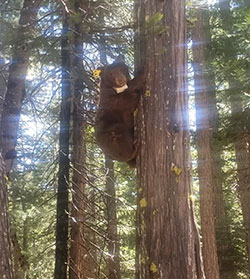
A collared bear near Blue Canyon in Placer County.
For years, California Department of Fish and Wildlife scientists were trying to locate dens for California’s Sierra Nevada red fox — a rare and threatened species whose population has decreased substantially. Scientists had a general idea that some of the foxes denned at high elevations in the Lassen Peak area, but aside from vague descriptions written in the 1920s, the den locations had never been documented.
In 2018, a team of scientists led by CDFW wildlife biologist Jennifer Carlson put GPS satellite collars on several Sierra Nevada Red Foxes. They were able to locate several dens in 2018 and 2019 and are in the process of verifying at least two more. Through collar technology and field work they have also verified that the population they were tracking has successfully raised litters.
“Knowing basic information about where the foxes live and breed will help us develop conservation actions to benefit the species,” said Pete Figura, a CDFW wildlife management supervisor who has experience collaring many types of wildlife including deer, elk, Pacific fishers and band-tailed pigeons.
The conservation benefits of collar technology have been well documented. Perhaps slightly less well known is that collars are designed and deployed with animal welfare in mind, allowing study animals to reproduce, get the food they need, maintain a healthy weight and live full lives.
Scientists strive to use collars that weigh five percent or less of an animal’s body weight, and in some cases can use collars that weigh as little as one-and-a-half percent of an animal’s body weight. When possible, scientists use collars that feature a drop-off mechanism which releases the collar before its battery life runs out. The drop-off mechanism also ensures that the animal does not have to live the remainder of its life with an inactive collar. Drop-off collar technology isn’t yet available on some of the smallest collars but may be in the future. Biologists also use expandable collars for young animals that haven’t reached full size, allowing them to grow without being impeded by the collar.
CDFW uses collars that provide two types of telemetry data. The data is derived from three basic approaches:
- Collars that send out a VHF radio signal which researchers can detect or listen to with an antenna to determine an animal’s general location and whether it is alive or dead. Researchers must be relatively close to detect the VHF signal.
- Collars that passively receive a radio signal from satellites and collect GPS location and other data such as movement and temperature. The data are usually stored onboard the unit which needs to be retrieved and downloaded onto a computer. Some of these collars also allow researchers to download data remotely using a hand-held device, but researchers must be relatively close to the animal. These collars also incorporate the VHF radio signal technology described above.
- Collars that also communicate actively to satellites allowing researchers to access location data on their computers and communicate with the collars to change settings remotely (e.g., to change the data collection schedule during migration).
While CDFW collars many types of animals, ungulates (hooved mammals) are the largest group. At any given time, CDFW is collecting data from 500 or more collared ungulates across the state including deer, elk, pronghorn and bighorn sheep. The department collects data on collared ungulates for conservation purposes and to inform hunting limits. Scientists track movement, habitat use and survival and can collect data on everything from ambient temperature to the direction and speed the animal is traveling. Collars can also tell scientists when and where an animal has died and whether it is moving, feeding, or resting.
“We take very seriously our ethical obligation not to harm animals or unnecessarily cause them discomfort. We take great strides to ensure collars have the right fit and weight for the animal wearing them,” said David Casady, a CDFW wildlife biologist with extensive collaring experience.
Collars are typically made from foam and leather with a circuit board housed in strong metal or plastic casing. For data purposes, collars are designed so that the animal doesn’t behave differently than the rest of the population.
“The data we collect from a collared animal needs to be representative of the population at large or it’s not very applicable to our management and conservation efforts,” said Casady.
Data from collars allow CDFW to make well-informed, science-based management decisions. Although scientists in the field often have a solid understanding of the wildlife they research, thoroughly vetted data is what counts in the eyes of decision makers.
Wildlife Biologist Justin Dellinger researches mountain lions (and wolves) for CDFW. He’s seen valuable data come from the 70 to 80 collared lions currently being monitored throughout the state.
“With collared males that move around and look for new territory, data can show us where there’s a lack of habitat connectivity. We can use those data in developing movement corridors and road crossings. It can ultimately help our state’s lion population live full lives,” he said.
Dellinger can also attest to the fact that collared lions are able to reproduce. “A 10-year-old female collared lion that we’re monitoring recently had her fifth litter of kittens,” he said.
###
CDFW Photos. Top Photo: A collared deer at Bonita Meadows in Tulare County in 2017. The deer was collared as part of a long-term monitoring project.
Media Contact:
Ken Paglia, CDFW Communications, (916) 825-7120